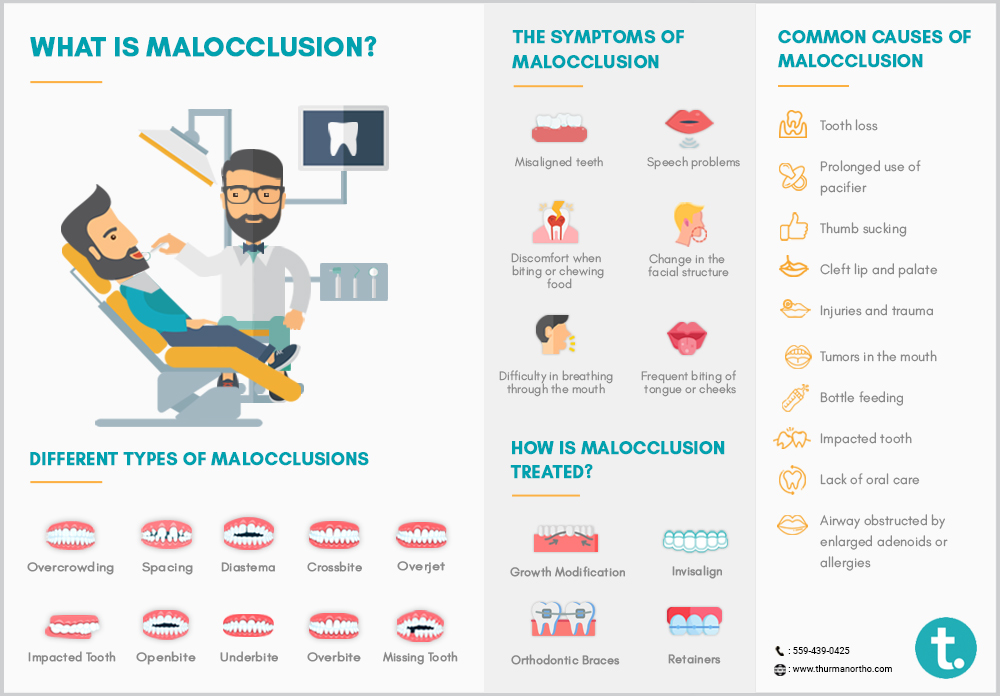What is Malocclusion?
Malocclusion is the clinical term for misaligned teeth that can lead to oral health complications like overbite, underbite, crossbite, and overcrowding. As the teeth are misaligned, it becomes difficult to perform vital oral functions like chewing, biting and speaking but an orthodontist is specially trained in treating all types of malocclusions and can effectively correct the way your teeth line up in the jaw. Orthodontic treatment involves a variety of tools and techniques to move the misaligned jaw and crooked teeth into the right positions.
What Are The Three Types of Malocclusion Classes?
The classification of bites are broken up into three main categories: Class 1, 2, and 3
- 1
Class 1 Malocclusion
Class 1 malocclusion, also known as class 1 occlusion and class 1 bite is an overlap of upper teeth over the lower teeth. It happens due to prolonged bottle use or thumb sucking in childhood. But it doesn’t affect your bite that much and can be fixed with minor malocclusion treatment. Class 1 malocclusion of teeth has 3 types. The teeth lean towards the tongue in type 1. In type 2, lower teeth are angled towards the tongue, and upper teeth stick out in narrow arches. In type 3 of malocclusion, the upper teeth are crowded, and they lean towards the tongue.
- 2
Class 2 Malocclusion
Class 2 malocclusion, also known as class 2 occlusion and class 2 bite, also has the upper teeth sticking out over the lower teeth. But this malocclusion of teeth is severe enough to affect your bite significantly. It needs early orthodontic intervention. It may take time for malocclusion treatment to correct the alignment of your teeth. But it can be permanently treated. Class 2 malocclusion has 2 divisions. Upper teeth lean towards the lips in division 1. In division 2, the upper central incisors lean towards the tongue.
- 3
Class 3 Malocclusion
Class 3 malocclusion, also known as class 3 occlusion and class 3 bite is a type of underbite where the lower teeth stick out over the upper teeth. However, it can be a crossbite also when some upper teeth and some lower teeth overlap each other. Class 3 malocclusion is divided into 3 types based on the alignment of the teeth. In type 1, teeth form an abnormally shaped arch. In type 2 malocclusion of teeth, the lower front teeth are angled towards the tongue. And in type 3, the upper arch is abnormal and upper teeth are angled towards the tongue.
What Are The Different Types Of Malocclusions?
There are various types of bites teeth can show, which are listed below:
-
1. Overcrowding
Overcrowding is a common condition typically caused due to lack of space resulting from overlapping or crooked teeth.
-
2. Spacing
When there is too much or too little space for the teeth, it results in crowding which can adversely impact the eruption of permanent teeth.
-
3. Openbite
When the upper and lower front teeth do not overlap each other, it results in the formation of an opening that leads straight into the mouth. The problem of an open bite can also occur on the sides of the mouth.
-
4. Overjet
An overjet is when the top front teeth extend beyond the lower front teeth horizontally, interfering with the functions of chewing food and speaking.
-
5. Overbite
Some overlapping of the lower front teeth is natural but when the upper front teeth are biting down right into the gums, an increased overbite is caused where the lower front teeth can also bite into the roof of the mouth.
-
6. Underbite
When the lower front teeth are positioned far forward than the upper front teeth, it results in an underbite which is also known as anterior crossbite.
-
7. Crossbite
A crossbite can happen on either or both the sides of the jaw when the upper front teeth are biting right inside the lower teeth. The condition can also affect your front or back teeth.
-
8. Diastema
Diastema refers to the space between two adjacent teeth, usually the front teeth.
-
9. Impacted Tooth
An impacted tooth is the one that cannot erupt from the gum naturally and needs to be extracted or exposed so that a brace can be fitted.
-
10. Missing tooth
Also known as hypdontia, this condition occurs as a result of trauma or improper development of teeth.
What are The Common Causes of Malocclusion?
Typically an inherited condition that is passed from one generation to the next, dental malocclusion can also occur due to certain conditions or habits that induce changes in the shape and structure of the jaw. A common cause is too much or too little room to erupt as a result of which the teeth tend to drift out of their place. Other major causes of dental malocclusion include:
- Tooth loss
- Prolonged use of pacifier
- Thumb sucking
- Cleft lip and palate
- Injuries and trauma
- Tumors in the mouth
- Bottle feeding
- Impacted tooth
- Lack of oral care
- Airway obstructed by enlarged adenoids or allergies
What Are The Symptoms of Malocclusion?
Depending on the type of malocclusion, the symptoms may be may be mild, moderate or severe. Common symptoms include:
- Misaligned teeth / Abnormal Alignment of teeth
- Discomfort when biting or chewing food (Uneven Bite)
- Speech problems
- Difficulty in breathing through the mouth
- Frequent biting of tongue or cheeks
- Change in the facial structure
How To Diagnose Malocclusion?
A dentist checks for malocclusion in children during regular dental visits and if the teeth seem out of line or the jaw appears distorted, the child may be referred to an orthodontist. The orthodontist will then examine:
- The child’s medical history to identify past health problems
- The teeth and mouth
- X-rays of the teeth and face
As recommended by The American Association of Orthodontists, every child should get a dental check up with an orthodontist by the age of seven and regular dental visits should commence at the age of 12 months. Regular dental visits help in the identification of dental problems early on so that treatment can be initiated in time.
How to fix malocclusion?
-
Braces
Braces are one of the proven and oldest malocclusion treatments. Sometimes certain teeth need to be extracted before starting braces treatment in kids and teens. Braces straighten the teeth and jaw to fix your smile and misaligned bite. Your orthodontist might prescribe metal or ceramic or lingual braces. It will depend on the severity of your malocclusion of teeth.
-
Removable Devices like Retainers
Removable orthodontic devices are popular for malocclusion treatment because of the convenience it provides. They are generally custom-made for you. Some examples of removable devices are retainers and headgears. Retainer trays maintain the alignment of teeth corrected by orthodontic treatments like braces. The duration of treatment for a misaligned bite can vary depending on the severity of the malocclusion and the patient’s compliance with wearing their custom-made removable retainers or headgears.
-
Invisalign
Invisalign can treat all kinds of malocclusion of teeth, be it underbite, open bite, overbite, or crossbite. It is a set of clear plastic aligner trays. Therefore, it is invisible to others. Invisalign are removable, and you need to wear them for 20-22 hours a day. In that time, it exerts pressure on teeth and jaw for proper alignment. Invisalign provides you a perfect smile makeover while being discreet.
Orthodontic treatment usually takes up to 2 years but in case of an adult, it may take longer than planned. If you are an adult and your orthodontist suggests a jaw surgery, you can also consider a second opinion to ensure that you take a decision that you feel is right. Orthodontic treatment is for everyone regardless of age so if you want to know the best course of dental care or want to discuss your treatment options, contact Thurman Orthodontics today at 559-439-0425 and schedule your complimentary first visit.
Related Post: How to Close Gap in Teeth
FAQs
-
What does a normal bite look like?
In a healthy bite, your upper teeth should slightly overlap your lower teeth, and the points of your back teeth should fit into the grooves of the opposite teeth. If your jaw aligns like this, it indicates a normal and healthy bite.
-
Can invisalign fix malocclusion?
Yes,Invisalign is a treatment option that can help fix malocclusion. It uses clear aligners to gently move your teeth into the correct position over time. Invisalign is effective for mild to moderate cases of malocclusion. However, if you have a severe malocclusion, other orthodontic methods may be recommended. It’s important to consult with an orthodontist to see if Invisalign is a suitable option for your specific situation.
-
How to prevent malocclusion?
Malocclusion is often hereditary and cannot be prevented. To reduce the chances of malocclusion in your children, discourage thumb sucking. If you have lost teeth, consider replacing them with dental implants or bridges to help prevent malocclusion. Consult with a dentist for personalized advice.
-
What is a class 1 malocclusion?
Class 1 malocclusion refers to a mild dental misalignment where the upper teeth slightly overlap the lower teeth. This is the most common type of malocclusion and usually does not cause significant problems with your bite.
-
What is a class 2 malocclusion?
Class 2 malocclusion is a more severe form of dental misalignment where the upper teeth significantly protrude over the lower teeth. This type of malocclusion can affect your bite and overall dental health. It often requires early orthodontic intervention to correct the alignment of the teeth
-
What is a class 3 malocclusion?
Class 3 malocclusion is a significant dental misalignment where the lower teeth extend beyond the upper teeth. This condition is often referred to as an underbite. It can impact your bite function and facial aesthetics. Class 3 malocclusion may be caused by factors like genetics or improper jaw growth. Early orthodontic intervention is usually required to address this issue.

Dr. Brian Thurman has spent his entire life enjoying all the beauty that California has to offer. A Fresno native, he still escapes to the ocean or the mountains whenever his busy schedule allows. Driven by his love for natural beauty, Dr. Thurman enjoys creating beautiful smiles and healthy bites that last a lifetime. He is proud to be the only Ivy League trained Orthodontist in the Fresno/Clovis area.

